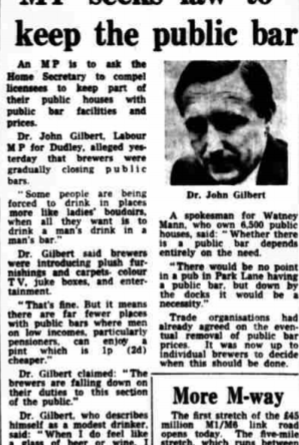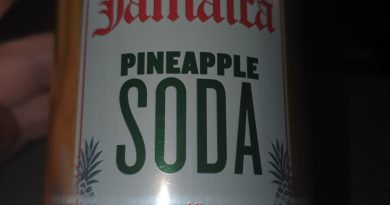Saloon Bars and Public Bars
This article was published fifty years ago today in the Birmingham Post and there’s an element of this being a watershed in the evolution of British pubs. The distinction between the public bar and the lounge (or saloon bar) was being removed and women were being encouraged to visit pubs, although there was some considerable way to go on that at the time. It meant that prices were being standardised across the two areas of the pub, and being realistic, that usually meant a price increase.
John Gilbert, the Labour MP for Dudley, wasn’t best pleased by all accounts, saying:
“Some people are being forced to drink in places more like ladies’ boudoirs, when all they want is to drink a man’s drink in a man’s bar”.
He commented on the influx of plush furnishings, carpets, colour TVs and jukeboxes, suggesting that this was forcing up prices. And fair play on this, a decent pub even fifty years on doesn’t need plush furnishings or carpets, and it certainly doesn’t need a colour TV or jukebox. Gilbert also described himself as “modest drinker”, which is a phrase that I’d use about myself, he sounds a rather measured man.
I quite like the response from Watney Mann, who the article noted owned 6,500 pubs:
“There would be no point in a pub on Park Lane having a public bar, but down by the docks it would be a necessity”.
As an aside, Watney Mann were the brewery who produced Red Barrel, not a product that would ever be called a craft beer, let’s say that. Indeed, they were probably pushing it calling it a beer and there’s an interesting article elsewhere about that. But without breweries such as this, maybe there wouldn’t have been a CAMRA…..
So, perhaps there’s something about the democratisation of the pub here, the removal of the class barriers between the different sections of the pub. I’ve seen articles written about how locals would ensconce themselves in the public bar, meaning that visitors would be encouraged to use the lounge bar. And that wouldn’t play well with how pubs are marketing themselves today, which is to a wider audience and not just to a small bunch of locals.
I normally rail against change, especially when pubs, railways or crisps are concerned. But here, I think the right decision was made, a pub for the many, not the few…. As for John Gilbert, he was probably right that pubs didn’t need this wave of plush furnishings and maybe chains like Greene King even today could focus more on the beer than their pub interiors, but I’m not convinced that every pub needed a public bar. And the Government agreed, the letter that Gilbert sent to the then Home Secretary Reg Maudling was in vain, the dual bar set-up was coming to an end.





